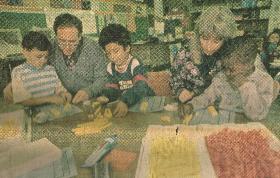
It All Adds Up
Starita Smith, Staff Reporter
Austin American-Statesman, February 25, 1993
The numbers are as large as Desiree Quintero, 7, is tiny. The first-grader at Waelder Elementary School easily subtracts 169,396 from 176, 543, borrowing three times as she works on each column of numbers.
Desiree isn’t the prodigy of her class. The problem she did came straight off the assignment sheet that every other first-grader in her class had to complete last week. Next door, kindergartners are practicing multiplication of fives; … in another room, fifth graders are adding and subtracting fractions.
These students are learning arithmetic through an innovative curriculum developed by Paul Shoecraft, a professor at the University of Houston at Victoria…. The curriculum, called MOVE IT Math, uses children’s love of playing games, singing and dancing to teach them arithmetic.
The 130 students at the school make up roughly half of the Waelder Independent School District in a small town about 55 miles southeast of Austin, said Norman Woolsey, elementary school principal. The students are 60 percent Hispanic, 30 percent black and 10 percent white. Most are from low-income families, he said.
It isn’t hard to find schools with largely minority and poor enrollments in Austin and throughout the nation. And it is at those schools where a growing achievement gap in test scores between white students and minority students has been documented. But in Waelder, that scenario is changing.
In the 18 months the school has used MOVE IT Math, scores on national and statewide standardized tests have risen significantly. In 1991, 65 percent of third-graders mastered the math section of the Texas Assessment of Academic Skills exam. In 1992, that figure jumped to 93 percent. The one student who did not pass had transferred from another district, Woolsey said.
Pupils are performing at least a grade level higher than their peers on the Comprehensive Test of Basic Skills, a national exam. Second-graders’ math skills were at the mid-fourth-grade level, for example.
In fact, the program’s results have gotten notice in high places. Gov. Ann Richards has praised MOVE IT Math, said Leticia Vasquez, a spokeswoman for the governor’s office. “She likes that program. She saw it in action in Victoria about two years ago and was very impressed, as was (state Comptroller) John Sharp,” Vasquez said.
Paul Shoecraft never doubted that students could learn math; he used to wonder why people thought math was so
difficult. Then he realized that children are not taught to think about math in the way that those who are naturally talented with numbers think about it.
They don’t learn the real meanings behind the symbols. For example, an equal sign means “balanced” or “is the same as.” In MOVE IT classes, first graders can play with a little balance beam on which they can hang little plastic sticks. The beam, which resembles a miniature seesaw, is balanced only when equivalent weights are on both sides.
MOVE IT Math also teaches students to see addition, subtraction, multiplication and division as combining and separating actions and to use a set of counting skills instead of memorizing math facts
As word about the program has spread, it has attracted admirers who praise it as the way to turn around the slug-gish test scores, boredom and anxiety that math spells for many students, and detractors, who are skeptical and criticize it as sort of a glorified finger counting system.
“It’s very impressive when you first see it because the kids are manipulating large numbers,” said Timy Baranoff, who observed MOVE IT Math when the Austin Independent School District was considering the curriculum several years ago. “It’s very showy.”
Baranoff, who retired last month, is former AISD director of elementary instruction and curriculum. She said she did not like the curriculum because she was concerned that young students did not have a firm grasp of basics that they would need later on.
“Are the kids truly understanding what’s happening when they are manipulating those huge numbers?” she asked.
Ann Powell, AISD math coordinator for grades kindergarten through 12, shares Baranoff’s feelings. She said she did not see the children being taught problem solving; instead, they were being taught computation.
“Computation is when you give the child a page of basic problems to work in addition or subtraction. Problem xxxx

Paul Shoecraft, developer of MOVE IT Math, works with first-graders Darwin Jones, left, Juan Cabarello, and Brandon Hull at Waelder Elementary School in Waelder. Test scores for students have improved using the new system.
Next > | New Math Formula | Kindermath | Demonstration | Federal Funding | Inservice Funded | Anyone Can Learn Math | Summer Volunteers | Monster Math | Making Math Fun | Area Leaders | New Math of 90s | Video | MOVE IT! | Math Made Easy | VIPS to View Pgm | Gov. Richards | Richard's Attention | Revolution | Adds Up | Mexico | Letter | Atlanta 2003 | < Back — HOME
